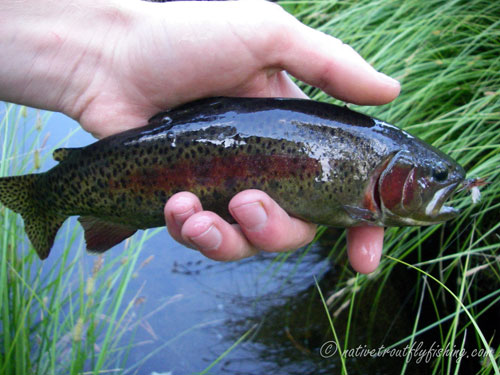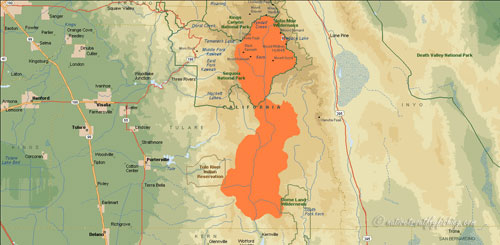Kern River Rainbow Trout
Oncorhynchus mykiss gilberti
A darkly colored Kern River Rainbow Trout from a small stream in southern California.
Introduction
The Kern River Rainbow Trout inhabits the mainstem of the Kern River and several of its tributaries above Lake Isabella in California. Historically, Kern River Rainbow Trout were native to the Kern River downstream of Lake Isabelle but have since been extirpated from that part of their range. This fish is thought to be an intermediate form between Golden Trout and Coastal Rainbow Trout, the latter of which are thought to have gained periodic access to the basin during the Pleistocene epoch (Behnke 2002). Due to this, the classification of the Kern River Rainbow Trout has been controversial, taxonomic analysis suggested that the Kern River Rainbow Trout is distinct enough to warrant subspecies status (Gold and Gall 1975). This is supported by genetic analysis, which suggests that the Kern River Rainbow Trout is distinctive and probably arose from an early natural invasion of Coastal Rainbow Trout that hybridized with Little Kern Golden Trout (Stephens 2007, Moyle et al. 2017). Despite this and its name, the Kern River Rainbow Trout is more closely related to both the California Golden Trout and Little Kern Golden Trout than to other Rainbow Trout populations (Erickson 2013). The coloration of these fish is more subdued than that of the other two Golden Trout subspecies but is more brilliant than that of Coastal Rainbow Trout.
Life History Information
No formal studies have investigated that life history of the Kern River Rainbow Trout, but they are thought to exhibit both stream resident and fluvial life history strategies. The Kern River Rainbow Trout are generalists and will opportunistically feed on what is available, as such aquatic and terrestrial invertebrates, which make up the majority of their diet. Due to the size of the Kern River Basin and greater availability of food, fluvial fish in the Kern River have been known to reach sizes up to 28 inches (71 cm) and 8 pounds (3.6 kg), while small stream resident fish usually have a maximum size of about 12 inches (30 cm). According to Behnke (2002) these fish typically spawn in April and May, with the first spawning between age-two to age-four.
Status
As most of the native range of the Kern River Rainbow Trout falls within the Golden Trout Wilderness Area, Sequoia National Forest or Sequoia National Park, their habitat remains in good condition. The primary impacts to their habitat come from either recreational uses or grazing. When I fished for these trout in a tributary to the Kern River 2007, cattle were grazing right up to the banks of stream, resulting in increased sedimentation, and incising of the stream channel, which appeared to be a factor leading to a depressed population. Like other western native trout, non-native trout currently present the greatest threat to the Kern River Rainbow Trout. Brook Trout and Brown Trout have been introduced into some streams, particularly in the southern part of the Kern River Rainbow Troutís native range and compete with and prey on the Kern River Rainbow Trout. However, the introduction of hatchery Rainbow Trout as well as Golden Trout, poses the biggest threat to the Kern River Rainbow Trout, as these fish readily hybridize with each other. Hatchery Rainbow Trout have been continually stocked in the Kern River and its tributaries for more than 100 years and the fish found in the Kern River show evidence of hybridization (Behnke 2002). Due to this, the genetics trout found downstream of the forks of the Kern River are dominated by hatchery Rainbow Trout genes. A somewhat intact population of Kern River Rainbow Trout is currently found in the Kern River upstream of Durwood Creek (Stephens et al. 1995). Erickson (2013) showed that of 21 localities assessed only seven populations found in small streams or lakes had low levels of hybridization. While historic hatchery practices continue to haunt the Kern River Rainbow Trout, the California Department of Fish and Wildlife has transitioned all trout plants in the basin to use native Kern River Rainbow Trout, which at least shows a step in the right direction to maintain these unique trout.
Description
The Kern River Rainbow Trout is much more brilliantly colored than Coastal Rainbow Trout. The coloration of the backs on these is ranges from a greenish olive to a bronze color. The side of the body is a golden-yellow color but is much more subdued than on the other two subspecies of Golden Trout and can be quite dull in some fish. Their bellies are typically an orange color, but once again are much more subdued than the other subspecies of Golden Trout. The spots on the Kern River Rainbow Trout are smaller, more irregular shaped and more profusely distributed than on the two subspecies of Golden Trout and are typically found across the entire body, instead of being isolated above the lateral line. Juvenile or small stream fish typically display around ten purplish colored parr marks along the lateral line. A crimson-colored stripe is found along the lateral line, and a similar color is found on the gill plates. The fins are a yellow or orange color, and the pelvic, anal and dorsal fins are darkly bordered and tipped with white.
Native Range
A map of the native range of the Kern River rainbow trout. Data Source: Behnke (2002).
References
Behnke, R. 2002. Trout and Salmon of North America. Chanticleer Press, New York.
Erickson, B. 2013. The search for the Kern River rainbow trout: conservation genetics of a native trout. Ph.D. Dissertation. University of California, Davis.
Gold, J.R. and G.A.E. Gall. 1975. The taxonomic structure of six Golden Trout (Salmo aquabonita) populations from the Sierra Nevada, California (Pisces: Salmonidae). Proceedings of the California Academy of Science Fourth Series: XL(10): 243-263.
Moyle, P.B., R.A. Lusardi, P.J. Samuel and J.V.E. Katz. 2017. State of the salmonids: status of California's emblematic fishes 2017. Center for Watershed Sciences, University of California, Davis and California Trout, San Francisco, CA. 579 pp.
Stephens, M.R. 2007. Systematics, genetics and conservation of Golden Trout. Dissertation. University of California, Davis, California.
Stephens, S.J., D.P. Christenson, M. Lechner and H. Werner. 1995. Upper Kern Basin management plan. A Cooperative Program of California Fish and Game, Sequoia National Forest and Sequoia National Park.
Contact
Feel free to contact me if you have any questions or comments
Kern River Rainbow Trout Links
California Department of Fish and Wildlife - Kern River Rainbow Trout Angling
Lower Kern River - Sequoia National Forest
Native Trout Links
Truchas Mexicanas' - Native Trout of Mexico
Balkan Trout Restoration Group
Trout and Seasons of the Mountain Village - About Japanese Trout
Western Native Trout Challenge
California Heritage Trout Challenge
Fly Fishing Blogs
Dave B's Blog: Fly Fishing for Native Trout
The Search for Native Salmonids
Conservation Links
Western Native Trout Initiative
Fly Fishing Links
Fishing Art Links
Americanfishes.com - Joseph R. Tomelleri

